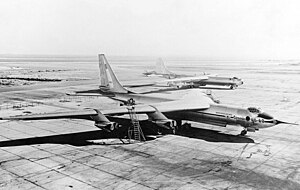Convair YB-60
| YB-60 | |
|---|---|
 |
|
| YB-60 prototype, Convair B-36F in the background | |
| Role | Strategic bomber |
| Manufacturer | Convair |
| First flight | 18 April 1952 |
| Status | Canceled 14 August 1952 |
| Number built | 1 complete, 1 partial |
| Program cost | US$14.3 million for program |
| Developed from | Convair B-36 |
The Convair YB-60 was an American prototype bomber aircraft for the United States Air Force, canceled on 14 August 1952.
On 25 August 1950, Convair issued a formal proposal for a swept-winged version of the B-36 with all-jet propulsion. The United States Air Force was sufficiently interested that on 15 March 1951, it authorized Convair to convert two B-36Fs (49-2676 and 49-2684) as B-36Gs. Since the aircraft was so radically different from the existing B-36, the designation was soon changed to YB-60.
The YB-60 had 72% parts commonality with its piston-engined predecessor. The fuselages of the two aircraft were largely identical, although the YB-60 had a longer, pointed nose with a needle-like instrument probe instead of the B-36's rounded nose; its tail surfaces were swept to match the wings and a wedge-shaped insert added at the wing root. The swept wings also used many B-36 parts.
The YB-60's unofficial competitor for an Air Force contract was Boeing's B-52 Stratofortress. Convair's proposal was substantially cheaper than Boeing's, since it involved modifying an existing design rather than starting from scratch. Like the B-52, it was powered by eight Pratt & Whitney J57-P-3 turbojets mounted in pairs in four pods suspended below the wing.
Instead of the B-36's crew of 15, the YB-60's crew numbered 10. Production B-60s were to have defensive armament similar to those of the B-36.
Convair YB-60 serial number 49-2676 made its maiden flight on 18 April 1952, piloted by Beryl Erickson. The Boeing YB-52 beat the Convair aircraft into the air by three days. The YB-60 was approximately 100 mph (160 km/h) slower than the YB-52 and also had severe handling problems. It carried a heavier bomb load — 72,000 lb (33,000 kg) against 43,000 lb (20,000 kg) for the YB-52 — but the Air Force did not see the need for the extra capacity, given the YB-60's other drawbacks. Later, "big belly" modifications increased the B-52's bomb load to 60,000 pounds (27,000 kg).
The flight test programs were canceled on 20 January 1953, with 66 flying hours accumulated. A second prototype was never completed: the airframe was built, but it was not fitted with engines or much equipment. Since Convair completed their prototype contract satisfactorily, both YB-60s were formally accepted by the Air Force in 1954. The operational aircraft never flew again, and both airframes were scrapped by July.
...
Wikipedia
